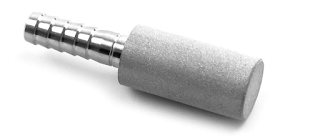The best aeration pumps provide an efficient and inexpensive way to aerate the wort in your primary fermenter.
An aquarium pump forces room air through a properly sanitized tubing. The air is delivered then delivered the wort through a diffusion stone. This promotes rapid absorption into the wort.
So what pumps do this the best?
 Smarter brewers than I have worked out that your wort should ideally have an oxygen level of 8 ppm (parts per million) before pitching the yeast.
Smarter brewers than I have worked out that your wort should ideally have an oxygen level of 8 ppm (parts per million) before pitching the yeast.The reality is that many brewers only achieve between 2.5 - 4.5 ppm if they do not aerate with a pump.
By using this wort aeration system you can probably easily double the oxygenation you might normally be getting.
A brewer who brought this unit on Amazon left this genuine review:
“Works great! Bubbles quite a bit, and foamed out of the top (mainly because I didn't leave enough room), but I didn't have any issues at all. My yeast took off like a bat out of hell when I pitched, which seemed to be better than when I didn't oxygenate in the past. I would highly recommend this to any homebrewer looking to improve fermentation.”
What are you waiting for?
Incomplete fermentation to occur?
Check out the price on Amazon:
Eagle Brewing FE380 Aeration System
Attach the ⅜-inch transfer tubing to the unit and your stone and you will be aerating in no time.
There’s not much more to say about this unit, it’s basically 'plug and play' once you’ve submerged the stone at the base of the fermenter.
Just bear in mind that the tubing (as with all pumps) will be wound up on arrival due to packaging constraints so you may want to stretch it out a bit so it settles on the bottom of the fermenter.
Check out the price on Amazon:
Here’s a funny thing we learned.
Diffusion stones are not actually made of stone.
How about that eh?
They are actually made of stainless steel which is added to a porous mold.
They do work a treat in making bubbles get that oxygen into your beer. You’ll want your stone to have a micron level of between .5 to 2 microns. This is pretty standard for brewers.
When using a diffusion stone you’ll want to ensure that you’ve sanitized it in an appropriate sanitization solution (don’t forget the tubing as well!).
I’ve read some punters warn that your hand can leave natural oils on the unit which can then clog it up - I say if you’ve washed your hands prior to use, then you should be fine.
It can be hard to attach a diffusion stone to the tubing. Instead of trying to force it in, place the end of the tubing in some near boiling water for a short time. This should soften the tubing enough so you can insert the stone’s connector part.
When placing your stone in the wort, you want it to get to the bottom of the fermenter, not near the top. If your tubing is a bit curly, you may want to try and straighten it out.
If this continues to be a problem, you may wish to consider using an oxygenation wand which will sit quite nicely in the fermenter, ensuring the oxygen bubbles start at the bottom and filter into the whole wort.
Learn more about oxygen wand kits here!
Just bear in mind that the tubing (as with all pumps) will be wound up on arrival due to packaging constraints so you may want to stretch it out a bit so it settles on the bottom of the fermenter.
Check out the price on Amazon:
Using diffusion stones to oxygenate beer wort
Diffusion stones are not actually made of stone.
How about that eh?
They are actually made of stainless steel which is added to a porous mold.
They do work a treat in making bubbles get that oxygen into your beer. You’ll want your stone to have a micron level of between .5 to 2 microns. This is pretty standard for brewers.
When using a diffusion stone you’ll want to ensure that you’ve sanitized it in an appropriate sanitization solution (don’t forget the tubing as well!).
I’ve read some punters warn that your hand can leave natural oils on the unit which can then clog it up - I say if you’ve washed your hands prior to use, then you should be fine.
It can be hard to attach a diffusion stone to the tubing. Instead of trying to force it in, place the end of the tubing in some near boiling water for a short time. This should soften the tubing enough so you can insert the stone’s connector part.
When placing your stone in the wort, you want it to get to the bottom of the fermenter, not near the top. If your tubing is a bit curly, you may want to try and straighten it out.
If this continues to be a problem, you may wish to consider using an oxygenation wand which will sit quite nicely in the fermenter, ensuring the oxygen bubbles start at the bottom and filter into the whole wort.
Learn more about oxygen wand kits here!


0 comments:
Post a Comment